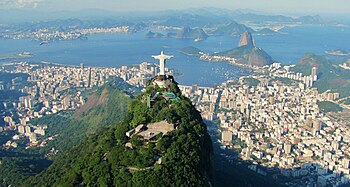
Back السياحة في البرازيل Arabic Braziliyada turizm Azerbaijani Tourismus in Brasilien German Turismo en Brasil Spanish Tourisme au Brésil French Pelancongan di Brazil Malay Turismo no Brasil Portuguese Turismul în Brazilia Romanian Туризм в Бразилии Russian


Tourism is a growing sector and key to the economy of several regions of Brazil. The country had 6.589 million visitors in 2018, ranking in terms of the international tourist arrivals as the second main destination in South America after Argentina and third in Latin America after Mexico and Argentina.[2] Revenues from international tourists reached US$5.8 billion in 2015, continuing a recovery trend from the 2008–2009 economic crisis.[3]
Brazil offers for both domestic and international tourists an ample range of options, with natural areas being its most popular tourism product, a combination of leisure and recreation, mainly sun and beach, and adventure travel, as well as historic and cultural tourism. Among the most popular destinations are beaches at Rio de Janeiro and Santa Catarina, beaches and dunes in the Northeast Region, business trips to São Paulo city, cultural and historic tourism in Minas Gerais, the Iguazu Falls and the Pantanal in the Center-West Region.[4]
In terms of the 2024 Travel and Tourism Competitiveness Index (TTCI), which is a measurement of the factors that make it attractive to develop business in the travel and tourism industry of individual countries, Brazil ranked in the 26th place at the world's level, third in the Americas, after Canada and United States.[5] Brazil main competitive advantages are its natural resources, which ranked 3rd on this criterion out of all countries considered in the Americas, and ranked 2nd for its cultural resources, due to its many World Heritage Sites.[6] The 2013 TTCI report also notes Brazil's main weaknesses: its ground transport infrastructure remains underdeveloped (ranked 129th), with the quality of roads ranking in the 121st place, and quality of air transport infrastructure in 131st; and the country continues to suffer from a lack of price competitiveness (ranked 126th), due in part to high and increasing ticket taxes and airport charges, as well as high and rising prices more generally. Safety and security improved significantly between 2008 and 2013, moving from 128th to 73rd place,[7] before slipping to 106th by 2017.[8]
Foreign tourists mainly come from Argentina, Uruguay, Paraguay, Bolivia, Peru, Ecuador, Colombia, Venezuela, Costa Rica, Mexico, Cuba, the Dominican Republic, the United States, Canada, China, South Korea, Japan, Australia, Chile, Spain, Italy, France, Germany, the United Kingdom, Greece, Ireland, the Netherlands, Belgium, Switzerland, Portugal, and Russia.
- ^ O Globo (18 March 2014). "Praia de Fernando de Noronha é eleita a mais bonita do mundo". Retrieved 4 January 2018.
- ^ UNWTO Tourism Highlights, 2016 Edition. 2016. doi:10.18111/9789284418145. ISBN 9789284418145.
- ^ Cite error: The named reference
WTO2013Highlightswas invoked but never defined (see the help page). - ^ Statistical Yearbook for Tourism 2020 base year 2019, page 331 of the PDF file (in Portuguese)
- ^ "2. At a glance: Travel & Tourism Development Index 2024 overall rankings - Travel & Tourism Development Index 2024 - World Economic Forum". World Economic Forum. May 2024. Retrieved 2024-07-10.
- ^ "6. Regional results - Travel & Tourism Development Index 2024 - World Economic Forum". World Economic Forum. May 2024. Retrieved 2024-07-10.
- ^ Jennifer Blanke and Thea Chiesa, ed. (2013). "Travel & Tourism Competitiveness Report 2013" (PDF). World Economic Forum, Geneva, Switzerland. Retrieved 2013-04-14. See Table 4, pp. 18-19 and Country/Economy Profile: Brazil, pp. 116-117.
- ^ "The Travel & Tourism Competitiveness Report 2017" (PDF). World Economic Forum. April 2017.